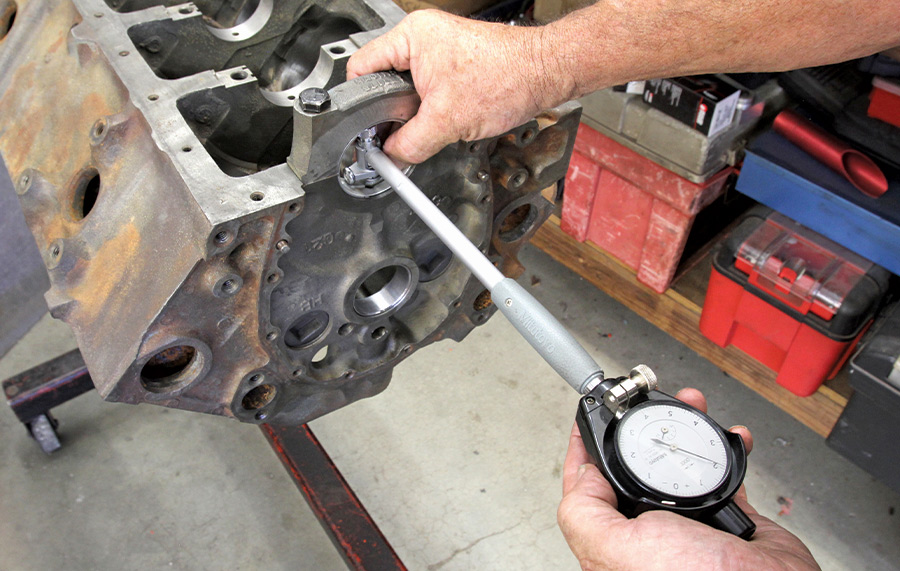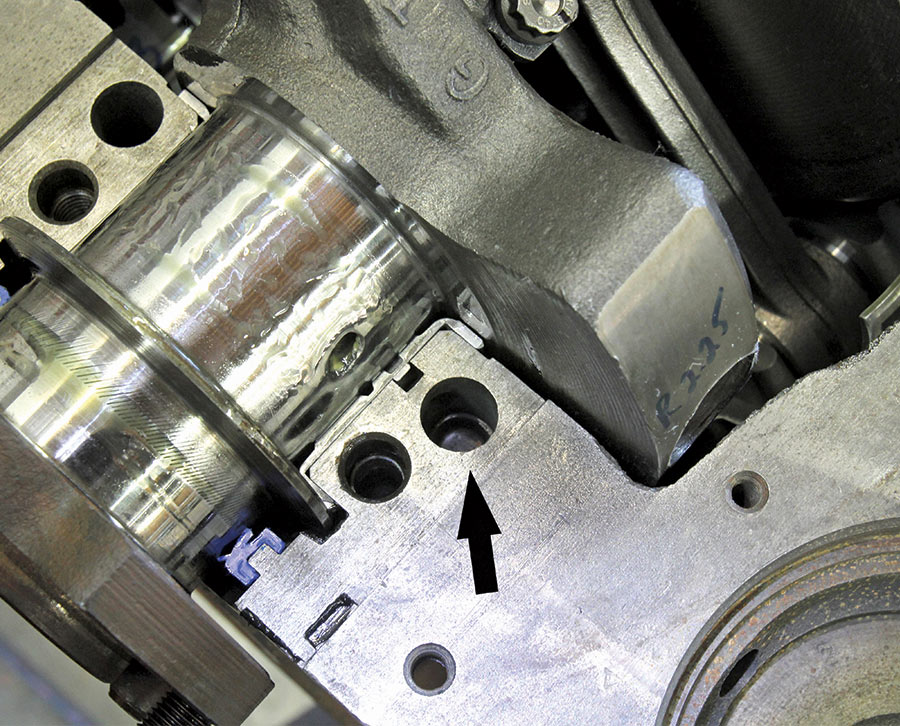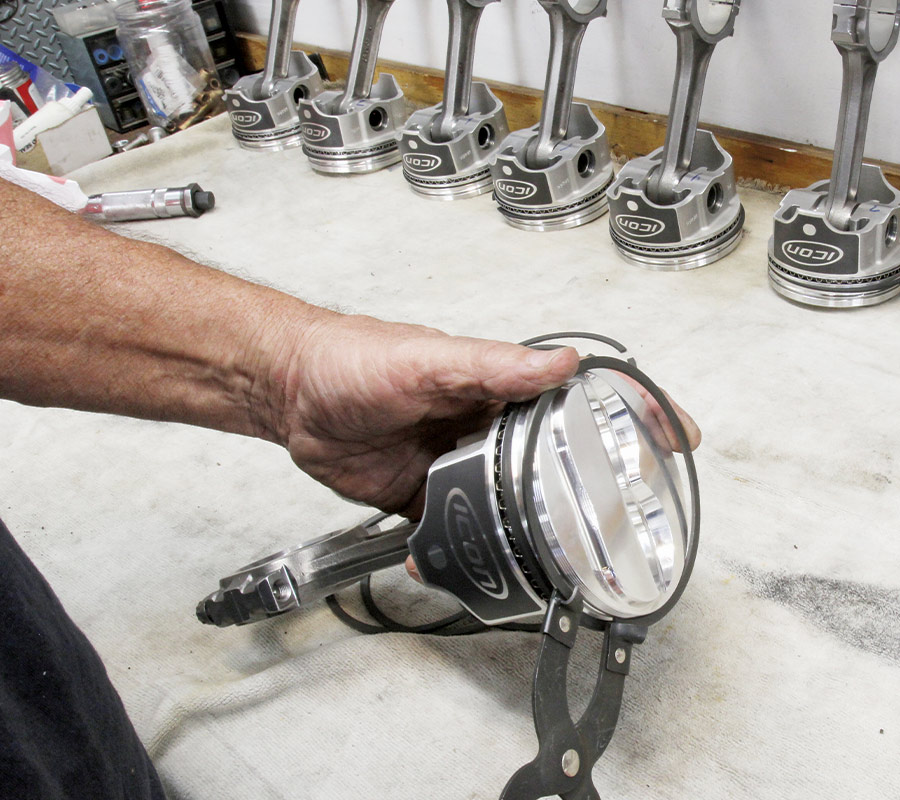 TECH
TECH
 Photography by The Author & Cam Benty
Photography by The Author & Cam Bentytreet car engine building is not always about ultimate power. Sometimes it’s more about projecting the right image. Steve Strope had a vision—a Pure Vision, if you will—which happens to be the name of his car building company—to construct an early 327ci Chevy with an early ’70s vibe for a project car that he’s assembling.
One secret to successful car building is to project a consistent theme. Strope had an early 327 small-journal block, crank, and a pair of ’70s large-chamber heads and he wanted those parts assembled into a streetable small-block.
The plan was to build a streetable 327 with its factory steel crankshaft into a suitable little small-block with decent compression, a nice lope to the cam, and a tunnel ram with a pair of Holley 600 carburetors. We’ll be honest and say that most of Strope’s ideas had merit–except for maybe the heads. But that’s what he wanted, so that’s what we built.
The heads he dropped off were a pair of 3973487 castings that trace back to 1971 and the low-compression version of the LT1 350 engine. These heads featured screw-in studs, guideplates, 2.02/1.60-inch valves, and decent ports for castings that have survived more than 50 trips around the sun. They are not bad heads, but then neither are they great. But they are what he wanted to use because they take him back to a time in his life when these were sought-after pieces.
This changed the packaging of this little 327 when it came time to choose pistons. First off, our compression ratio program spelled out bad news if we were to stick with a generic flat-top, four-eyebrow piston. A flat-top piston with a 3.25-inch stroke matched with a 74cc chamber would drop the compression to a paltry 8.75:1. Since this engine needed to be snappy, we decided to add compression by adding a small dome to the piston.
We had already decided against a hypereutectic piston as Strope liked the idea of strength from a forged piston. A short search brought us to an ICON piston with a 6.3cc dome that could pump the compression up to 9.8:1 using a 0.010-inch deck and a 0.041-inch-thick composite head gasket.
The issue with a domed piston is that it impedes the combustion process by lengthening the path of the flame front. A much better solution would have been a more modern aftermarket head with a tighter, 62cc chamber and a flat-top piston. This would have created an improved 10.15:1 compression ratio that would also shorten the path traveled by the flame front with no peaks or valleys.
If we were searching for ultimate power, we would also have decked the block to bring the pistons up to near zero deck, or we could have ordered a thinner head gasket to improve power. But that wasn’t necessary here.
With compression now settled, we continued the vintage vibe by selecting a flat-tappet, hydraulic camshaft. Summit Racing offers a line of Muscle Car camshafts that dial it back to the bygone era. From a wide list of potential candidates, we selected a cam that emulates the original L79 350hp 327 camshaft that was used in Corvettes, Chevelles, and the Chevy II.
We’ve included the cam specs in a separate chart but with a relatively short duration of 221 and a wide lobe separation angle (LSA) of 114 degrees, this cam will offer a mild lobe, yet still deliver some decent power with valve lift approaching 0.450 inch. This cam seemed like the perfect match to Strope’s visual approach with the engine.
We had Don Barrington at Barrington Engines in Canyon Country, California, just north of Los Angeles perform the basic block restoration routines that included boring 0.060-over and torque plate honing. This block has seen some rough times and it also demanded line honing of the mains. The 0.060-inch overbore was necessary to clean up a nasty ridge at the top of several cylinders. This is near the outside edge of the bore envelope, but this block was up to the challenge with sufficiently thick cylinder walls.
The cost to rebuild the stock connecting rods was close enough to the price of a new set of Scat 5.7-inch rods, which made the selection easy. Barrington installed the floating pins and opened up the small ends slightly to ensure there was room for lubrication. The ICON pistons were machined for the classic 1/16-, 1/16-, 3/16-inch ring package and we filled those with a set of Hastings rings that we custom set the endgaps using Summit Racing’s electric ring grinder.
We also used a set of Clevite rod and main bearings to complete the rotating assembly after the entire package was balanced by our friends at SoCal Diesel in Santa Clarita, California. Our standard preassembly ritual checked all the important clearances, including rod, main, and crankshaft endplay dimensions. Once the block machining was completed, the assembly procedure went smoothly.
After washing the block, it’s still not clean. We used white paper towels and a splash of Marvel Mystery oil to deep clean the honing grooves. We keep wiping with a new towel until it comes back red and not gray. This will also keep that honing grit out of the oil during new engine startup.
Strope wanted a little flash to bleed through this build so he spec’d a finned, cast-aluminum pan for the small-block and we finished that off with a specific package of a high-volume oil pump with an extended pickup to better use all the oil that this pan could contain.
Having already chosen the cam to use, the only other requirement was to degree it in using a new Cloyes timing chain set and using our degree wheel to ensure the numbers were all in agreement.
Barrington had also tapped the front oil galley holes for us as well, which makes the plugs less likely to push out under high oil pressure. This is a good idea for early blocks like this one that had already been rebuilt at least once. Now it was onto assembling the top half of the engine.
We chose to assemble the heads ourselves to reduce the bill at the machine shop and also to ensure that we removed the inner springs in order to reduce the load on the camshaft during break-in. This is an important step because the break-in process is critical and even with high-zinc Summit Break-In SAE30 oil, a reduced spring load will also greatly assist in establishing a proper wear pattern on all 16 lobes.
With the heads torqued in place with ARP bolts with sealant on the threads to prevent any coolant leakage into the oil, the final step was to install the intake. Strope wanted an older-style tunnel ram that we found used with a pair of Holley 600-cfm vacuum secondary carburetors. This package looks wild and also harkens back to the early ’70s look that he was after. The final piece is an early small-block distributor to finish off the look with smaller 7mm plug wires.
Strope also took the time to remove all the external casting flash from the block and heads and then painted the engine with actual Chevy Hugger Orange automotive paint after making sure the block and heads were surgically clean. The overall effect is stunning and will look outstanding sitting in his ’29 roadster pickup. Even if it is just another small-block Chevy, this one will run as good as it looks.

















 SOURCES
SOURCES(661) 298-7790